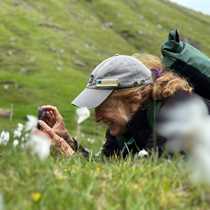East on the Columbia River
Today we awoke to a changed landscape. Gone were the green, tree lined hillsides of Portland. This morning the slopes wore a cloak of cropped golden grasses trimmed with downy fluffs of gray clouds. The low clouds gave way to patches of blue sky, and we looked hopefully eastward for a sunny afternoon.
In his presentation this morning, Tom Schmidt, our National Geographic Historian, introduced us to the Corps of Discovery. Comparing the personalities of the two Captains, it was easy to see what a complimentary team these two multi-skilled men formed. Meriwether Lewis was an eager explorer with an inquisitive mind and meticulous observation skills. William Clark, also an experienced explorer, had the more even temperament as well as exceptional cartographic skills.
During Tom’s presentation, he shared with us the maps available in 1804 and the supposition of a symmetrical North American landscape. The anticipation was for a gentle ascent westward after crossing the prairie, an ascent as gentle as the Appalachian Mountains in the east. Facing the reality of a snow-capped Rocky Mountain skyline was most certainly a disheartening moment for the Corps of Discovery. This was one of many moments where the leadership and motivation skills of the two Captains were put to a test.
After lunch our Expedition Leader, Jackson Zimmerman, gave a presentation on Pacific salmon. There are numerous challenges faced by these fish today, and they were summarized into the five categories of habitat, hydropower, hatcheries, harvest, and aquaculture. The program was enlightening and the question forum at the end illustrated a great interest in this much-debated topic.
The late afternoon found us basking on deck with the basaltic cliffs of Wallula Gap as a dramatic backdrop. Our day ended with a golden sunset to the west, and we made our turn to starboard, continuing east onto the Snake River, in search of blue skies for tomorrow’s adventures.
Today we awoke to a changed landscape. Gone were the green, tree lined hillsides of Portland. This morning the slopes wore a cloak of cropped golden grasses trimmed with downy fluffs of gray clouds. The low clouds gave way to patches of blue sky, and we looked hopefully eastward for a sunny afternoon.
In his presentation this morning, Tom Schmidt, our National Geographic Historian, introduced us to the Corps of Discovery. Comparing the personalities of the two Captains, it was easy to see what a complimentary team these two multi-skilled men formed. Meriwether Lewis was an eager explorer with an inquisitive mind and meticulous observation skills. William Clark, also an experienced explorer, had the more even temperament as well as exceptional cartographic skills.
During Tom’s presentation, he shared with us the maps available in 1804 and the supposition of a symmetrical North American landscape. The anticipation was for a gentle ascent westward after crossing the prairie, an ascent as gentle as the Appalachian Mountains in the east. Facing the reality of a snow-capped Rocky Mountain skyline was most certainly a disheartening moment for the Corps of Discovery. This was one of many moments where the leadership and motivation skills of the two Captains were put to a test.
After lunch our Expedition Leader, Jackson Zimmerman, gave a presentation on Pacific salmon. There are numerous challenges faced by these fish today, and they were summarized into the five categories of habitat, hydropower, hatcheries, harvest, and aquaculture. The program was enlightening and the question forum at the end illustrated a great interest in this much-debated topic.
The late afternoon found us basking on deck with the basaltic cliffs of Wallula Gap as a dramatic backdrop. Our day ended with a golden sunset to the west, and we made our turn to starboard, continuing east onto the Snake River, in search of blue skies for tomorrow’s adventures.



